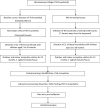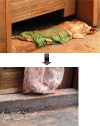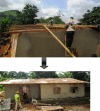The effect of improved housing on indoor mosquito density and exposure to malaria in the rural community of Minkoameyos, Centre Region of Cameroon
- PMID: 32362282
- PMCID: PMC7197188
- DOI: 10.1186/s12936-020-03232-6
The effect of improved housing on indoor mosquito density and exposure to malaria in the rural community of Minkoameyos, Centre Region of Cameroon
Abstract
Background: This study evaluated the effectiveness of improved housing on indoor residual mosquito density and exposure to infected Anophelines in Minkoameyos, a rural community in southern forested Cameroon.
Methods: Following the identification of housing factors affecting malaria prevalence in 2013, 218 houses were improved by screening the doors and windows, installing plywood ceilings on open eaves and closing holes on walls and doors. Monthly entomological surveys were conducted in a sample of 21 improved and 21 non-improved houses from November 2014 to October 2015. Mosquitoes sampled from night collections on human volunteers were identified morphologically and their parity status determined. Mosquito infectivity was verified through Plasmodium falciparum CSP ELISA and the average entomological inoculation rates determined. A Reduction Factor (RF), defined as the ratio of the values for mosquitoes collected outdoor to those collected indoor was calculated in improved houses (RFI) and non-improved houses (RFN). An Intervention Effect (IE = RFI/RFN) measured the true effect of the intervention. Chi square test was used to determine variable significance. The threshold for statistical significance was set at P < 0.05.
Results: A total of 1113 mosquitoes were collected comprising Anopheles sp (58.6%), Culex sp (36.4%), Aedes sp (2.5%), Mansonia sp (2.4%) and Coquillettidia sp (0.2%). Amongst the Anophelines were Anopheles gambiae sensu lato (s.l.) (95.2%), Anopheles funestus (2.9%), Anopheles ziemanni (0.2%), Anopheles brohieri (1.2%) and Anopheles paludis (0.5%). Anopheles gambiae sensu stricto (s.s.) was the only An. gambiae sibling species found. The intervention reduced the indoor Anopheles density by 1.8-fold (RFI = 3.99; RFN = 2.21; P = 0.001). The indoor density of parous Anopheles was reduced by 1.7-fold (RFI = 3.99; RFN = 2.21; P = 0.04) and that of infected Anopheles by 1.8-fold (RFI = 3.26; RFN = 1.78; P = 0.04). Indoor peak biting rates were observed between 02 a.m. to 04 a.m. in non-improved houses and from 02 a.m. to 06 a.m. in improved houses.
Conclusion: Housing improvement contributed to reducing indoor residual anopheline density and malaria transmission. This highlights the need for policy specialists to further evaluate and promote aspects of house design as a complementary control tool that could reduce indoor human-vector contact and malaria transmission in similar epidemiological settings.
Keywords: Anopheles density; Cameroon; Housing improvement; Malaria transmission; Rural community.
Conflict of interest statement
The authors declare that they have no competing interests.
Figures










References
-
- WHO. World Malaria Report 2012. Geneva, World Health Organization, 2012. http://www.who.int/malaria/publications/world_malaria_report_2012/report.... Acessed 21 Jun 2018.
-
- WHO. World Malaria Report 2013. Geneva, World Health Organization, 2013. http://www.who.int/malaria/publications/world_malaria_report_2013/report.... Assessed 21 Jun 2018.
-
- National Malaria Control Programme Cameroon. National Malaria Strategic Plan 2014–2018. Yaoundé, 2014. p. 106.
-
- National Institute of Statistics Cameroon, Ministry of Economy planning and regional developement Cameroon, Ministry of Public health Cameroon, ICF International. Multiple Indicator Demographic Health Survey 2011. Yaoundé, 2012. p. 576.
-
- WHO . Malaria vector control and personal protection: report of a WHO Study Group on Malaria Vector Control and Personal Protection. Geneva: World Health Organization; 2006. p. 62. - PubMed
MeSH terms
Grants and funding
LinkOut - more resources
Full Text Sources
Medical

